Themed collection Energy storage with rechargeable Li batteries and beyond

Cation-intercalation and conversion-type cathode materials for rechargeable aluminum batteries
This review provides an overview of the research on cation-intercalation and conversion-type cathodes for rechargeable Al batteries. The mechanisms behind the experimental observations are discussed to highlight the complexity of Al electrochemistry.

Mater. Chem. Front., 2022,6, 280-296
https://doi.org/10.1039/D1QM01267C
Strategies, design and synthesis of advanced nanostructured electrodes for rechargeable batteries
In this review, a wide range of advanced strategies are discussed and summarized for the development of high performance electrodes for rechargeable batteries.
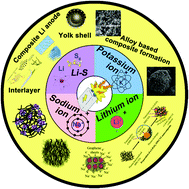
Mater. Chem. Front., 2021,5, 5897-5931
https://doi.org/10.1039/D1QM00274K
Sustainable bio-derived materials for addressing critical problems of next-generation high-capacity lithium-ion batteries
Sustainable bio-derived materials solve the critical issues of low ionic and electrical conductivity, large volume variation, lithium dendrite formation, and the shuttle effect of the sulfur cathode in lithium-ion batteries.
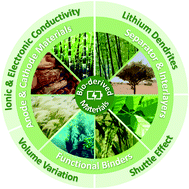
Mater. Chem. Front., 2021,5, 5932-5953
https://doi.org/10.1039/D1QM00255D
Recent advancements of functional gel polymer electrolytes for rechargeable lithium–metal batteries
A comprehensive review of the latest advancements of functional gel polymer electrolytes, focused on the thermal response behavior, metallic lithium anode and cathode in lithium–metal batteries.
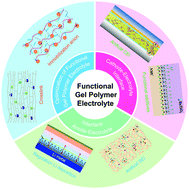
Mater. Chem. Front., 2021,5, 5211-5232
https://doi.org/10.1039/D1QM00096A
Materials chemistry among the artificial solid electrolyte interphases of metallic lithium anodes
The progress of artificial SEI established by precursors with distinguished chemical compositions are summarized, and outlooks are proposed for the lithium-metal anode investigations regarding comprehensive SEI chemistry identifications.
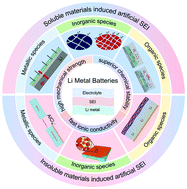
Mater. Chem. Front., 2021,5, 5194-5210
https://doi.org/10.1039/D1QM00352F
(S)TEM-EELS as an advanced characterization technique for lithium-ion batteries
(Scanning) transmission electron microscopy–electron energy loss spectroscopy is used as an advanced nano-scale characterization method to clarify the ion diffusion, charge transfer and structure change occurring in lithium-ion batteries.
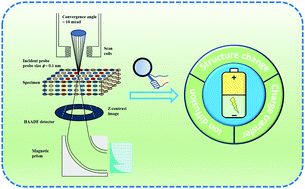
Mater. Chem. Front., 2021,5, 5186-5193
https://doi.org/10.1039/D1QM00275A
Recent progress of emerging cathode materials for sodium ion batteries
We summarized the recent progress of cathode materials used for SIBs and modified strategies, expecting to give an inspiration for the development of high-performance cathode materials.

Mater. Chem. Front., 2021,5, 3735-3764
https://doi.org/10.1039/D1QM00179E
Understanding the Ni-rich layered structure materials for high-energy density lithium-ion batteries
The development of electric and hybrid electric vehicles has emerged as one of the most promising strategies for solving the global shortage of fossil energy problem.

Mater. Chem. Front., 2021,5, 2607-2622
https://doi.org/10.1039/D1QM00052G
Challenges and strategies of zinc anode for aqueous zinc-ion batteries
The obstacles of dendrite growth, hydrogen evolution, corrosion and passivation of the zinc anode seriously restrict the cycling stability of aqueous zinc-ion batteries which possess high safety and low cost.

Mater. Chem. Front., 2021,5, 2201-2217
https://doi.org/10.1039/D0QM00693A
Electrolyte additive enabled low temperature lithium metal batteries
A dioxolane (DOL)-based electrolyte with dimethyl sulfoxide (DMSO) additive enabled high performance of lithium metal batteries under extremely cold conditions by constructing a robust solid electrolyte interphase (SEI) on the lithium anode.
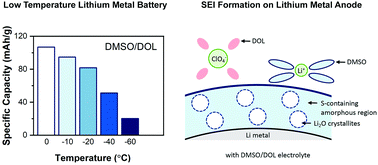
Mater. Chem. Front., 2022,6, 1405-1413
https://doi.org/10.1039/D2QM00180B
Temperature-regulated biomass-derived hard carbon as a superior anode for sodium-ion batteries
In this work, the Na+ storage mechanism of golden berry leaf-derived hard carbon can be divided into three stages: adsorption, intercalation and filling, and the storage mechanism evolves with the increase of carbonization temperature.

Mater. Chem. Front., 2021,5, 7595-7605
https://doi.org/10.1039/D1QM00911G
Porous polyimide framework based on perylene and triazine for reversible potassium-ion storage
A porous polyimide framework was prepared via condensation between perylenetetracarboxylic dianhydride and triazine and investigated as an electrode material for reversible K+-ion storage. It exhibited a large reversible capacity, good rate performance, and long cycling stability up to 1000 cycles at 5 A g−1.
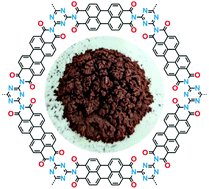
Mater. Chem. Front., 2021,5, 7184-7190
https://doi.org/10.1039/D1QM00843A
Constructing a stable interface between the sulfide electrolyte and the Li metal anode via a Li+-conductive gel polymer interlayer
An in situ derived Li+-conductive gel polymer interlayer enables intimate solid–solid contact and uniform Li+ flux at the Li/Li10GeP2S12 heterointerface and effectively inhibits interfacial reactions and Li dendrite growth.
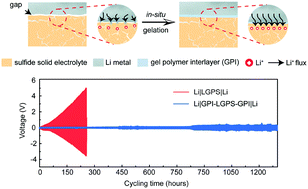
Mater. Chem. Front., 2021,5, 5328-5335
https://doi.org/10.1039/D1QM00395J
Suppressing multiphase transitions of an O3-NaNi0.5Mn0.5O2 cathode by iron and magnesium co-doping towards sodium-ion batteries
Fe/Mg co-doped O3-NaNi0.35Fe0.2Mg0.05Mn0.4O2 was prepared as a cathode material for SIBs, and it delivered a decent electrochemical performance for the half and full SIBs due to its suppressed complex monoclinic phase transition.

Mater. Chem. Front., 2021,5, 5344-5350
https://doi.org/10.1039/D1QM00079A
Chlorine-doped Li1.3Al0.3Ti1.7(PO4)3 as an electrolyte for solid lithium metal batteries
Chlorine doping is an effective approach for improving performance of Li1.3Al0.3Ti1.7(PO4)3 (LATP) electrolyte. Compared with that of the LATP electrolyte, the lithium battery with LATP-0.4Cl exhibits good rate performance and cycling stability.
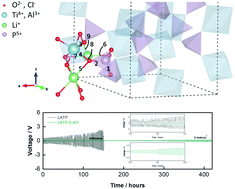
Mater. Chem. Front., 2021,5, 5336-5343
https://doi.org/10.1039/D1QM00241D
Solid-state integrated micro-supercapacitor array construction with low-cost porous biochar
Solid-state micro-supercapacitor arrays made from porous biochar are integrated on flexible substrates by screen printing and writing, providing new insights into exploring low cost, eco-friendly, large scale integrated micro energy storage devices.
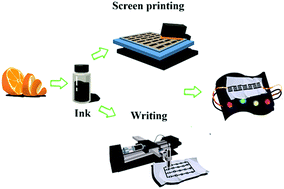
Mater. Chem. Front., 2021,5, 4772-4779
https://doi.org/10.1039/D1QM00240F
A topochemically constructed flexible heterogeneous vanadium-based electrocatalyst for boosted conversion kinetics of polysulfides in Li–S batteries
A novel flexible V2O3/VN heterostructure was constructed by a facile topochemical nitridation strategy and synergistically promoted the conversion of polysulfides in Li–S batteries.

Mater. Chem. Front., 2021,5, 3830-3840
https://doi.org/10.1039/D0QM01142H
Superior potassium and zinc storage in K-doped VO2(B) spheres
The K-doped VO2(B) electrode materials demonstrate enhanced ion diffusion coefficients and superior electrochemical performance both in potassium-ion batteries and zinc-ion batteries (e.g., 122 mA h g−1 at an extremely high rate of 50 A g−1).
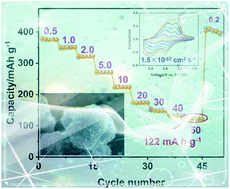
Mater. Chem. Front., 2021,5, 3132-3138
https://doi.org/10.1039/D0QM00990C
High-rate and non-toxic Na7Fe4.5(P2O7)4@C for quasi-solid-state sodium-ion batteries
A quasi-solid-state sodium-ion battery based on the Na7Fe4.5(P2O7)4@C cathode boosts high-rate performance and long lifespan.
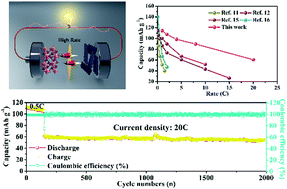
Mater. Chem. Front., 2021,5, 2783-2790
https://doi.org/10.1039/D0QM00847H
Glycolide additives enrich organic components in the solid electrolyte interphase enabling stable ultrathin lithium metal anodes
Glycolide (GL) is proposed as an electrolyte additive to prolong the cycle life of ultrathin Li metal anodes through the enrichment of the organic components in the working solid electrolyte interphase.
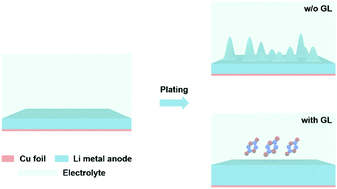
Mater. Chem. Front., 2021,5, 2791-2797
https://doi.org/10.1039/D0QM01134G
A controllable thermal-sensitivity separator with an organic–inorganic hybrid interlayer for high-safety lithium-ion batteries
The PAN/EVA@SiO2/PAN (PESP) separator fabricated by electrospinning approach exhibits a proper shutdown function at approximately 120 °C, which can greatly improve the safety of lithium-ion batteries.

Mater. Chem. Front., 2021,5, 2313-2319
https://doi.org/10.1039/D0QM01061H
A reinforced ceramic-coated separator by overall-covered modification of electron-insulated polypyrrole for the safe performance of lithium-ion batteries
A rational design for a reinforced ceramic-coated separator that has been further modified with polypyrrole is reported. The thermal-dimensional stability of the separator is greatly improved without increasing its thickness.
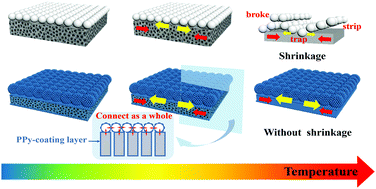
Mater. Chem. Front., 2021,5, 1884-1894
https://doi.org/10.1039/D0QM00849D
Boosting the ionic conductivity of PEO electrolytes by waste eggshell-derived fillers for high-performance solid lithium/sodium batteries
Poly(ethylene oxide) (PEO)-based polymer electrolytes are extensively investigated, and they have rapidly developed in all-solid-state batteries (ASSBs) over recent years for their good interface contact with electrodes, easy shaping and decent flexibility.
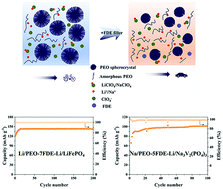
Mater. Chem. Front., 2021,5, 1315-1323
https://doi.org/10.1039/D0QM00541J
High-yielding carbon nanofibers grown on NIPS-derived porous nickel as a flexible electrode for supercapacitors
A flexible and robust 3D nickel@carbon nanofiber electrode was prepared via modified NIPS-powder metallurgy and CVD method. 3D porous nickel membrane provides more active catalysis sites and confined space for the growth of carbon nanofibers.

Mater. Chem. Front., 2020,4, 2976-2981
https://doi.org/10.1039/D0QM00483A
About this collection
Welcome to Materials Chemistry Frontiers themed collection on energy storage with rechargeable Li batteries and beyond.
On the way toward a sustainable energy economy, rechargeable lithium-ion batteries (LIBs) based on ion-intercalation chemistry have demonstrated their tremendous success in powering our daily life yet are gradually approaching the limitations on theoretical energy density and resource abundance. In light of the cost and abundance of Li, Na/K/Mg/Zn/Ca/Al are considered to be viable alternatives over Li for large-scale energy storage, yet questions still remain about the electrode materials, electrolytes, and electrode-electrolyte interface.
This collection provides a snapshot of the recent efforts that are dedicated to address these challenges in LIBs and related fields. It offers insights on the materials design, system optimization and storage chemistry of the state-of-the-art LIBs and beyond-Li storage technologies.
Guest Editors: Yu-Guo Guo (Institute of Chemistry, Chinese Academy of Sciences), Jun Lu (Argonne National Laboratory) and Shu-Lei Chou (University of Wollongong)
More articles will be added as soon as they are published.